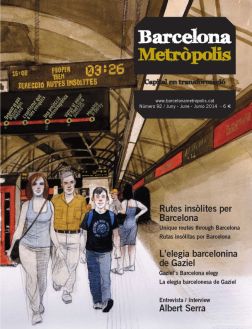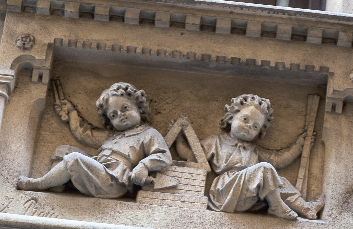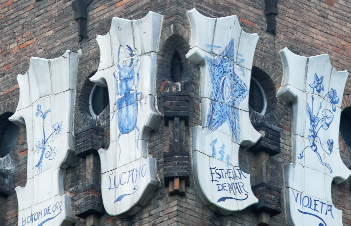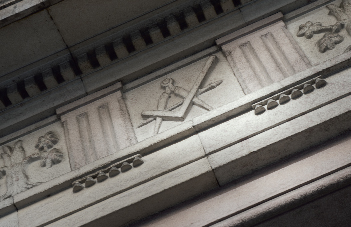At the top of an imposing staircase a replica of the Statue of Liberty welcomes visitors into the Arús Public Library. This is the first stop along the route initiating us into the symbols and areas in Barcelona related to Freemasonry.
Although Barcelona does not have as many Masonic symbols as other European cities there are still some that survived the bloody years of Francoist persecution. The dictator not only ordered the shooting, imprisoning and disabling of lodge members, he also gave instructions for the symbols on buildings, monuments and in cemeteries to be destroyed.
It is a miracle really that the Biblioteca Arús, at 26 Passeig de Sant Joan, is preserved intact and its treasures did not end up in the National Historical Archive in Salamanca, which was originally a documentation centre that directed the repression of Freemasonry and Communism. The library was donated to the city by the Catalan dramatist and journalist Rossend Arús, the great mid-19th-century proponent of Freemasonry in Catalonia, who left instructions in his will that his home be made into a library for the education of the working class. Freemasonry and the workers’ movement were his two great specialities. The confiscation order of the Franco police was never carried out. The library was simply closed and someone, who must have been fairly influential, ensured that no harm came to it until it reopened in the mid-1960s.
Here, at the beginning of the journey, we can already feel the mysterious atmosphere of the secret society, or discrete society, as the Masons prefer it to be known. There are hundreds of books to be consulted, and it has even been learnt that the colours of the Barça football club could have their origins in a lodge, the one to which Arús himself belonged, along with the Swiss Emili Gaissert, a relative of Joan Gamper, the founder of the Barça club, who he was host to in Barcelona.
Going down Passeig de Sant Joan and crossing Arc de Triomf and the Saló de Lluís Companys – the president of the Generalitat who was certainly a Mason – we arrive at Ciutadella Park, where we find, on the corner with Passeig de Picasso, the present day Natural Sciences Museum, a building also known as Castell dels Tres Dragons, the castle of three dragons. It was designed by Lluís Domènech i Montaner as a restaurant for the 1888 Universal Exposition. Its upper perimeter is ringed with ceramic pieces depicting animal species. One of them is a five-legged starfish, which has something similar to a G at its centre. It may be a coincidence, but a five-legged starfish with a G in the middle is one of Freemasonry’s most important symbols. The G represents origin – Genesis – Geometry and God.
Militia and food
Close to the Ciutadella is Carrer del Comerç, and before we get to the Born we find the 18th-century barracks constructed on the site of the former Convent de Sant Agustí, a building that now houses the Ciutat Vella Civic Centre, the Barcelona Photographic Archive and the Chocolate Museum. On two of the three doorways in Carrer Comerç we can see the best-known Masonic symbol, a set square and compass, which suggests this may have been a lodge, at the time of the Napoleonic occupation, or later, when it was home to the Acadèmia Militar de Matemàtiques. There is no symbol over the third door, but it is clear that it has been removed: it is probable that Franco’s soldiers got tired before finishing the job and left the other two doors intact.
Now we go towards the Born and Santa Maria del Mar to end up in Passeig d’Isabel II, where we find the well known Porxos d’en Xifré. The building was funded by Josep Xifré, a businessman who made his fortune in America. While many people imagine they see abundant Masonic elements on the front, these probably have more to do with the mythology of the sea and the Zodiac. Where we do find traces of Freemasonry is the well-known restaurant Set Portes, on the ground floor. It is said that the first owner, Josep Cuyàs, was a Mason, and in fact the establishment was frequented by many Masons during the 19th century. The chessboard floor, like those found in lodges, and the acacia leaves, another symbol of the Master Masons, distributed all round the restaurant suggests that events took place here that were somewhat more secret than the serving of coffees and food.
After this we can move on to find Carrer Avinyó. On arriving at number 27 we look for the bell to the Gran Logia Simbólica Española (GLSE), the second most important Masonic organisation in the country. If we have arranged a visit, or if we can convince someone who happens to be there, we can visit the temple and the other facilities. We can also try to pay a call on other organisations: the Gran Logia de España (Gran Via, 617), the Gran Logia Femenina de España (Josep Estivill, 32) and the Gran Orient de Catalunya (Mallorca, 125).
The Masons and the cathedral canon
The origins of Freemasonry date back to mediaeval cathedral builders’ guilds. To confirm this, we just need to go to Barcelona Cathedral where we will find the traces of these workers. They had extensive knowledge of geometry and shared moral and working norms, and they recognised each other through words and secret signs. They were organised into categories and had ceremonies, like the initiation of apprentices, in a small building located, logically, next to the cathedral, where they also relaxed, ate and kept their tools and plans.
First, let us have a look at the marks on many stones in the facade of the Santa Llúcia Chapel on Carrer del Bisbe. Working stone was such a specialised skill that each mason signed his work with an identifying symbol. Mediaeval Masonic set squares, compasses and other symbols are also found on some of the windows on the outer part of the apse.
Once within the temple, the most interesting part is the chapel dedicated to Sant Sebastià and Santa Tecla. This was financed in the 16th century by Canon Joan Andreu Sorts, who supervised the cathedral works. The relationship between the canon and the Masonic lodge must have been very important as it is reflected in the chapter’s coat of arms, which appears in various places in the chapel as well as on the tomb where his remains lie. On the shield is an open compass with its points facing upwards, a rose and two comets. This relationship between the old constructors’ guilds and people outside the profession was crucial in the emergence of modern Freemasonry.
Before leaving the old town behind, we can go to Carrer Portaferrissa, where the front door of number 11 bears a small sculpture of two children holding the tools of mediaeval masons.
From Cerdà to Ferrer
Leaving the Ciutat Vella, we enter the Eixample, work of the Mason Ildefons Cerdà. For a long time it was speculated that the engineer was a Mason, but there was no documentary evidence until a phrase was found in one of his diaries that could only have been uttered by a Mason. It was known, though, that one of his daughters, the concert musician Clotilde Cerdà, was a Mason.
There are other interesting Masonic places in Barcelona. On Montjuïc, on Avinguda de l’Estadi, there is a monument to Francesc Ferrer i Guàrdia, a Mason, anarchist and the founder of the Escola Moderna, who was accused of having incited Tragic Week and shot in 1909. The monument, a replica of one in Brussels, was sponsored by the foundation that bears the teacher’s name.
And finally, there is nothing like a walk through Barceloneta, where at number 8, Carrer de Santa Clara we find the La Fraternitat library, in the headquarters of a former workers cooperative of this name. On the facade is an extraordinary sculpture, undoubtedly of Masonic significance: two hands entwined in greeting, as the apprentices do, framed by a triangle. Before the Civil War, there were close links between Masonic lodges, workers cooperatives and cultural centres.








La lectura,me ha hecho sentirme en BArcelona, aunque este hoy lejos de ella; espero mejorar y volver a ella…
Hoy hemos estado visitando la biblioteca Arús y la Logia Masonica de la Granvia de las Corts Catalanas.Lo hemos pasado muy bien ya que hemos descubierto que nuestra vida ha sido una mentira continua. GRACIAS